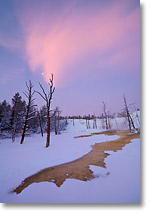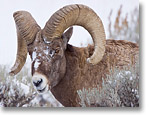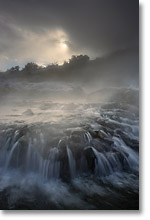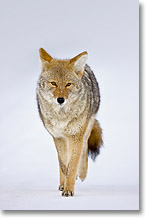|
Yellowstone National Park is one of the world’s most popular natural areas. Every year, millions of visitors from around the globe flock to the park to view its scenic grandeur and abundant wildlife. And every summer, the park’s hotels, trails, campgrounds, and roads get clogged with gawking tourists. For the serious nature photographer, it is often difficult to get even a little elbowroom, let alone to find a spot to set up one’s tripod.
Personally, I am never comfortable photographing in such situations. I prefer a little bit of solitude to allow me to explore my personal vision, and a healthy dose of discomfort doesn’t hurt either. In such circumstances, you increase your chances of experiencing something unique. If you feel the same way—or if you are simply a hard-core masochist (and let’s face it, all serious nature photographers are indeed just that)—then winter in Yellowstone is for you.
Winter in Yellowstone is a time of year when the pace slows, when tourist travel diminishes to a mere trickle, and only the brave (or foolish) set out with camera and tripod in the hopes of capturing unique images. It is a time of struggle for wildlife, of countless epic battles for survival between predator and prey, the outcome determining who lives another day, and who starves to death in the frozen waste. It is a time of deep snow and mercilessly cold temperatures that wreak havoc on equipment, batteries, and appendages. And above all, it is a whale of a good time!
What To Photograph
Yellowstone offers a myriad of choices when it comes to photography, even in winter. In terms of wildlife, you will have the opportunity to photograph bison, bighorn sheep, elk, mule deer, and coyote. Bald eagles, river otters, and trumpeter swans are also often seen during the winter. It you are lucky, you may spot wolf or even a mountain lion, but these species tend to avoid people and are difficult to get close enough to photograph. Although grizzly and black bears hibernate during the winter, winter sightings are not unheard of; grizzly bears will sometimes drive wolves away from a kill and claim it for their own.
In terms of landscape photography, Yellowstone’s many thermal features are especially appealing in winter, as the warm moisture rising from heated pools and vents turns to heavy steam in the cold air. Snow and ice features can make interesting subjects, although many of the thermal-warmed streams, rivers, and waterfalls in the park stay ice-free year round. High elevations and clear, cold nights make for excellent astrophotography conditions.
Auto Access
Adding to the challenge of photographing Yellowstone in winter is the fact that most of the park is inaccessible to auto traffic. Only the 50-mile stretch of road between the park’s North and Northeast entrances is plowed during the winter; access is possible only through the town of Gardiner, MT, just outside the North entrance. Of course, this road passes through some of Yellowstone’s prime wildlife habitat, including Lamar Valley. Bison, elk, and coyote are commonly seen along the drive. The park’s several dozen wolf packs also favor this part of the park. The most significant scenic feature that is road accessible is Mammoth Hot Springs, which contains several thermal pools, terraces, and mounds.
When driving in the park, make sure your car has snow tires, a good battery, and a proper antifreeze mixture—not having any of these can leave you stranded and possibly in trouble. Jumper cables or a back-up portable battery to get a dead car battery started are also a good idea, as well as winter survival gear in case you get stuck and need to wait a while before help arrives. Rangers regularly patrol the road so if you do have problems you shouldn’t have to wait too long, but it is better safe than sorry.
If spending a few days photographing along the road, there are lodging options in Gardiner (just outside the park) and within the town of Mammoth, which is just inside the park below the hot springs.
Interior Access
If you want to photograph some of the famous Yellowstone icons during winter, you will need to travel by snow coach or by snowmobile to access the park’s interior. As of this writing, snowmobile traffic inside the park is limited to groups or individuals traveling with a licensed guide. Snow coaches are vehicles with tracks or skis allowing them to travel the unplowed roads within the park’s interior.
If you wish to lodge within the park’s interior, your only option is the Old Faithful Snow Lodge. This, of course, is not a bad option at all, as it puts you in the heart of Yellowstone’s most famous scenic area. Snow coach tours depart from the towns of West Yellowstone and Mammoth to the Snow Lodge and back on a regular basis. Consider staying a few nights at the Snow Lodge so that you may explore and photograph the Upper Geyser Basin—home to Old Faithful as well as countless other geysers and thermal pools—to your heart’s content. Snowmobile and snow coach tours depart from the Snow Lodge on a daily basis to some of Yellowstone’s other scenic areas. Cross-country ski and snowshoe rentals are readily available at the lodge gift shop.
During the beginning of winter, wildlife is most concentrated in the northern part of the park, but as winter’s cold and snow deepen, wildlife moves south and congregates around the park’s thermal areas. This can make the Snow Lodge an especially appealing base camp, allowing for an unrivaled opportunity to get both great landscape and wildlife images.
Special Considerations
As frequently noted above, Yellowstone in winter can be a very cold and snowy place. Make sure to bring appropriate clothing and gear. Snowshoes or cross-country skis may be necessary to travel Yellowstone’s many trails (rentals are available both outside and inside the park). Fingers and toes can get very cold when standing around photographing wildlife or the landscape; insulated boots, wool socks, and thick mittens are a must.
Keeping fingers warm is often most difficult, as while photographing you must strike an appropriate balance between warmth and dexterity. I always wear a pair of gloves that are thick enough to provide some insulation but thin enough to allow me to operate tiny camera buttons and dials, stuffing my hands into thick insulated mittens whenever I can. Chemical hand and toe warmers can also be used to take the edge off of the cold. Dress in layers to that you may easily increase insulation when standing still and decrease insulation when moving around.
Cameras may have numerous problems in winter. Cold temperatures can quickly suck the life out of batteries. Always brings spares, and if possible, keep batteries in a warm pocket until they are needed. Shutter curtains sometimes freeze open or shut; if this happens, warm your camera as soon as possible until normal operation returns. Mist rising from thermal features can collect and freeze on tripod legs, cameras, and lenses, and mist and blowing snow can get inside cameras when changing lenses, so be especially careful. When returning indoors after being out in the cold for while, make sure you keep your equipment covered to prevent condensation caused by the sudden change in temperatures.
The Yellowstone backcountry can be an especially dangerous place in winter. If venturing far from the road or from the park’s well-traveled thermal features, make sure you have the skills, equipment, and physical fitness necessary to survive sudden harsh conditions. Leave an itinerary with someone before heading out. Avoid the temptation to get close to wild animals you encounter; bison, elk, and bear in particular can be unpredictable and highly dangerous, and they run much faster than humans. Better to keep your distance.
Final Thoughts
Although winter in Yellowstone can be challenging, the benefits outweigh the hardships. You will have the opportunity to photograph the park in a way that few ever see. Winter sharpens everything, reducing the landscape to graphic shapes, and adding a haunting poignancy to wildlife’s everyday struggle to survive. Don’t miss it!
Comments on NPN nature photography articles? Send them to the editor. NPN members may also log in and leave their comments below.
Ian Plant lives in the Washington, D.C. area and has been photographing the natural world for fifteen years. His work has appeared in a number of books and calendars, as well as national and regional magazines, including Outdoor Photographer, National Parks, Blue Ridge Country, Adirondack Life, Wonderful West Virginia, and Chesapeake Life, among others. His sixth and most recent book is the critically acclaimed Chesapeake: Bay of Light. Ian’s work has also appeared in five other books of the Wonder and Light series. Ian is co-owner of Mountain Trail Press, a publisher of fine art nature photography books and calendars.
To see more of Ian's work, visit Mountain Trail Photo. The Mountain Trail Photo Team consists of some of the top nature photographers in the country, whose mission is to educate and inspire others in the art of nature photography. There you will find team member images; articles on photo techniques and destinations; and information on workshops in some of America's most beautiful places. Also visit the Team's blog for a more eclectic mix of images and musings.




